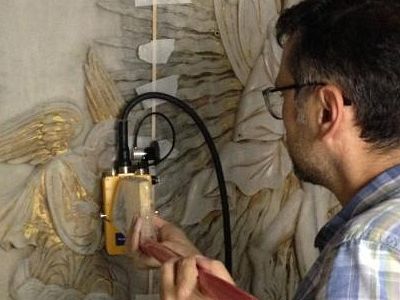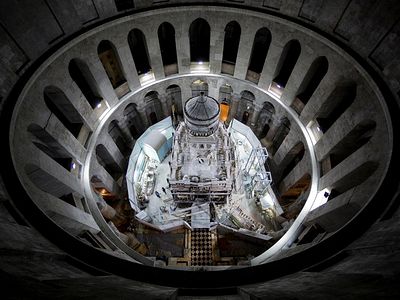Source: Daily Mail
November 24, 2016
The limestone slab where Jesus' body was said to have been laid out after his crucifixion was revealed last month for the first time since at least 1555 AD.
After removing the slab that encased the tomb, scientists were stunned to find the burial shelf intact and a second marble slab with a cross carved into its surface.
The tomb was opened and resealed within 60 hours during work being done at the Church of the Holy Sepulchre in the Old City of Jerusalem.
Now, new images have emerged revealing the restoration work on the stones that cover the outside of the tomb as well as an 18th century shrine known as the 'Edicule'.
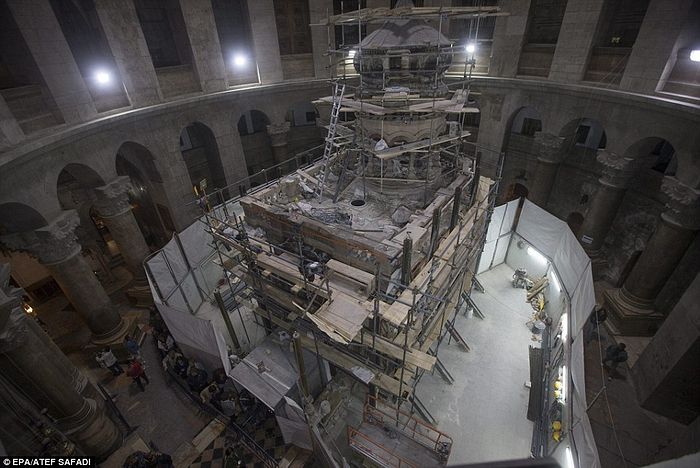 A view of the tomb and its shrine, surrounded by construction works. The burial slab was enclosed in an 18th century shrine structure known as the Edicule – a word derived from the Latin term aedicule meaning 'little house'. These steel girders supporting the Edicule will be removed when restoration work is finished next spring
A view of the tomb and its shrine, surrounded by construction works. The burial slab was enclosed in an 18th century shrine structure known as the Edicule – a word derived from the Latin term aedicule meaning 'little house'. These steel girders supporting the Edicule will be removed when restoration work is finished next spring
The Edicule - a word derived from the Latin term aedicule meaning 'little house' - was last reconstructed after a fire in the early 1800s.
The Greek Orthodox Church, the Roman Catholic Church and the Armenian Orthodox Church agreed in 1958 that conservation of the Edicule was needed.
But it's taken almost 50 years to get the $4 million (£3.2 million) of funding needed to restore it.
In the 1940s, iron bars were installed to keep the Edicule structure upright until the project started.
Now a team of engineers is injecting mortar around the marble slabs that make up the Edicule so that supports will no longer be needed.
Researchers were given the unprecedented access to the inside of the tomb within the Edicule as part of restoration work that started in October this year.
The team was shocked to find portions of the tomb are still intact today, having survived centuries of damage.
Until then, marble had encased the slab since at least 1555 AD, and likely centuries earlier.
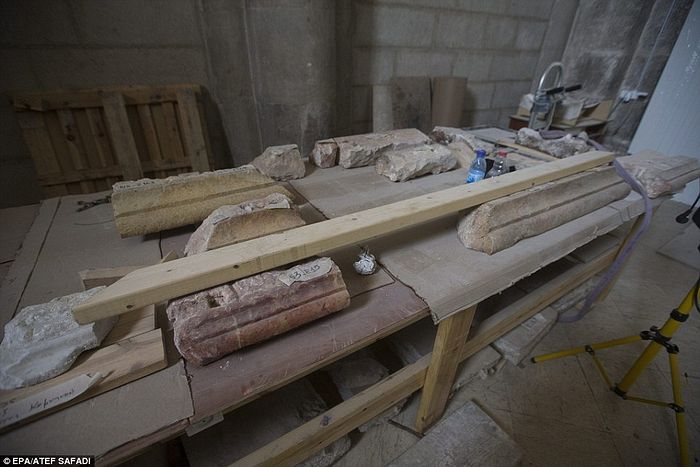 A view of the restoration work of stones from the Jesus tomb at the lab in the Franciscan Church at the Church of the Holy Sepulchre in the Old City of Jerusalem. The Edicule - a word derived from the Latin term aedicule meaning 'little house' - was last reconstructed after a fire in the early 1800s
A view of the restoration work of stones from the Jesus tomb at the lab in the Franciscan Church at the Church of the Holy Sepulchre in the Old City of Jerusalem. The Edicule - a word derived from the Latin term aedicule meaning 'little house' - was last reconstructed after a fire in the early 1800s
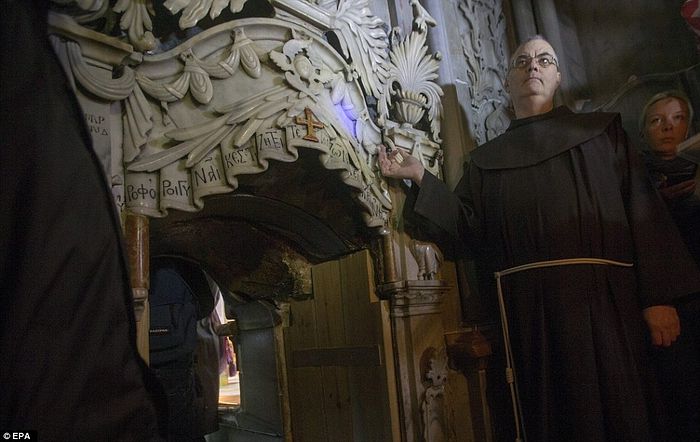 A Franciscan friar stands next to the tomb of Jesus Christ in the Church of the Holy Sepulchre in the old city of Jerusalem. The tomb has now been resealed and will probably not be opened again for hundreds, possibly even thousands, of years
A Franciscan friar stands next to the tomb of Jesus Christ in the Church of the Holy Sepulchre in the old city of Jerusalem. The tomb has now been resealed and will probably not be opened again for hundreds, possibly even thousands, of years
When work first began, the conservation team from the National Technical University of Athens showed only a layer of material underneath the marble slab.
But as researchers continued their work over the course of 60 hours - and with just a few hours left before the tomb was to be resealed, another marble slab with a cross carved into its surface was exposed.
The team cut a window into the southern interior wall of the Edicule, exposing one of the cave walls.
The tomb has now been resealed and will probably not be opened again for hundreds, possibly even thousands, of years. But before it was resealed, the surface of the rock was extensively catalogued.
Work on restoration of the Edicule is expected to continue for at least the next five months.
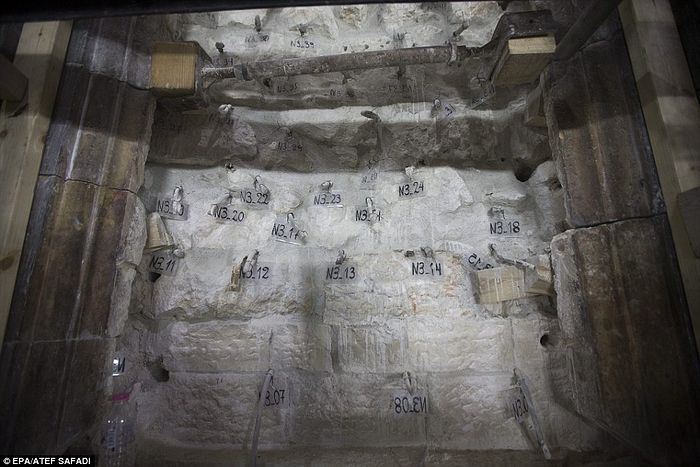 A view of the restoration works at the north wall of the tomb. The large archaeologist operation started on October as part of the conservation work in what believed to be the tomb of Jesus Christ
A view of the restoration works at the north wall of the tomb. The large archaeologist operation started on October as part of the conservation work in what believed to be the tomb of Jesus Christ
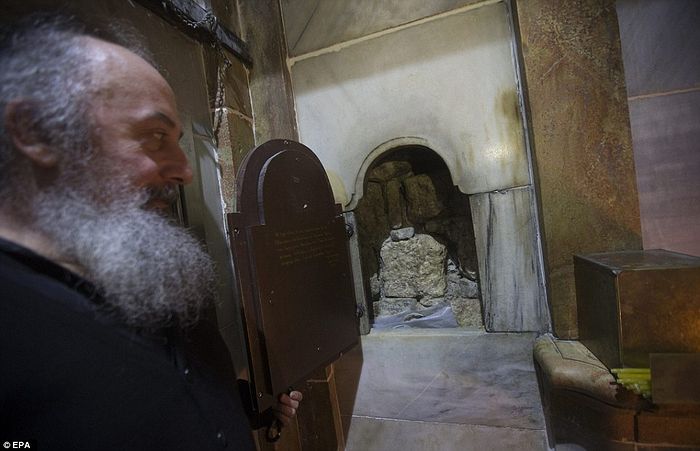 According to Christian tradition, Jesus body was laid on a shelf in a limestone cave following his crucifixion by the Romans in AD 30
According to Christian tradition, Jesus body was laid on a shelf in a limestone cave following his crucifixion by the Romans in AD 30
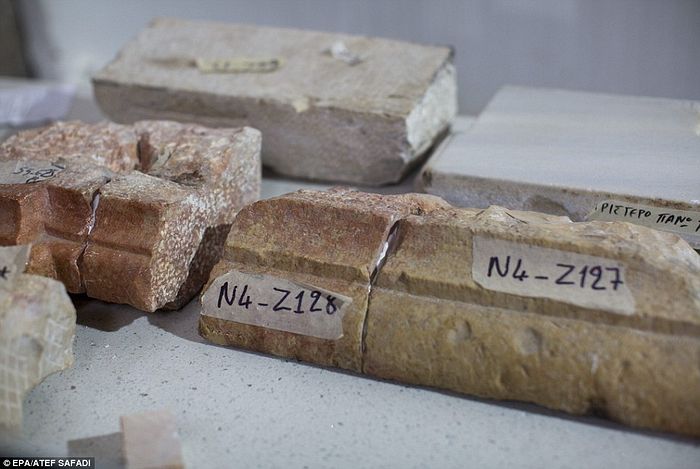 The restoration work of stones from the Jesus tomb. The team cut a window into the southern interior wall of the Edicule, exposing one of the cave walls
The restoration work of stones from the Jesus tomb. The team cut a window into the southern interior wall of the Edicule, exposing one of the cave walls
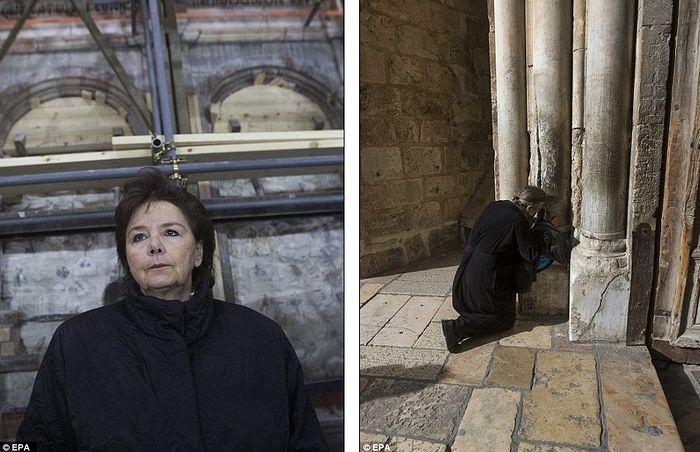 Antonia Moropoulou, professor at the National Technical University of Athens and the Chief Scientific Coordinator of the restoration project, shown left. A Christian pilgrim praying outside the Church, shown right
Antonia Moropoulou, professor at the National Technical University of Athens and the Chief Scientific Coordinator of the restoration project, shown left. A Christian pilgrim praying outside the Church, shown right
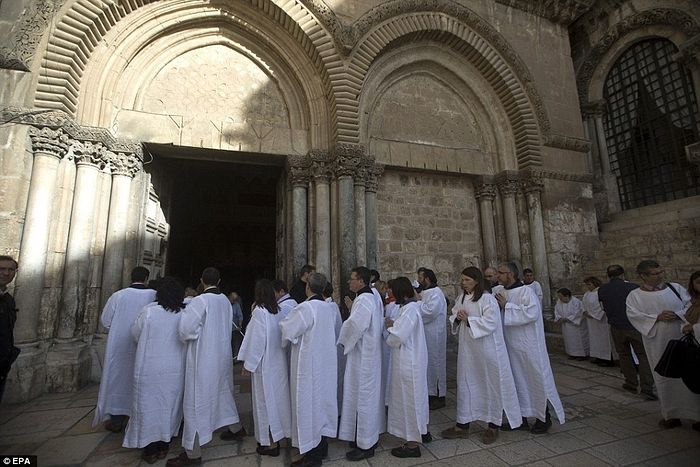 Christian pilgrims pray outside the Church of the Holy Sepulchre. Christian tradition says Christ's body was laid on a slab cut from a limestone cave after his crucifixion by the Romans
Christian pilgrims pray outside the Church of the Holy Sepulchre. Christian tradition says Christ's body was laid on a slab cut from a limestone cave after his crucifixion by the Romans
'I'm absolutely amazed. My knees are shaking a little bit because I wasn't expecting this,' said Fredrik Hiebert, archaeologist-in-residence at National Geographic, after opening up the tomb.
'We can't say 100 per cent, but it appears to be visible proof that the location of the tomb has not shifted through time, something that scientists and historians have wondered for decades.'
'This is the Holy Rock that has been revered for centuries, but only now can actually be seen,' said Antonia Moropoulou of the National Technical University of Athens, who is leading the restoration of the Edicule.
'The architectural conservation which we are implementing is intended to last forever,' says Moropoulou.
National Geographic has been filming the work being done at the church, which is considered the most sacred site in Christianity.
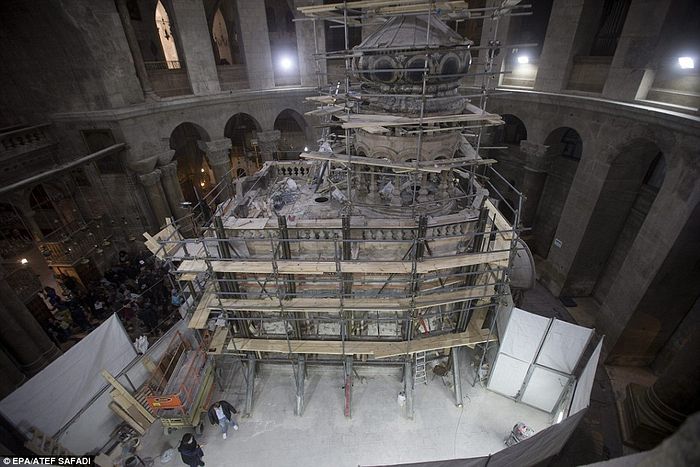 Work on restoration of the Edicule is expected to continue for at least the next five months. Broken or fragile pieces will be replaced and those sections which can be preserved will be cleaned, and the support structures reinforced
Work on restoration of the Edicule is expected to continue for at least the next five months. Broken or fragile pieces will be replaced and those sections which can be preserved will be cleaned, and the support structures reinforced
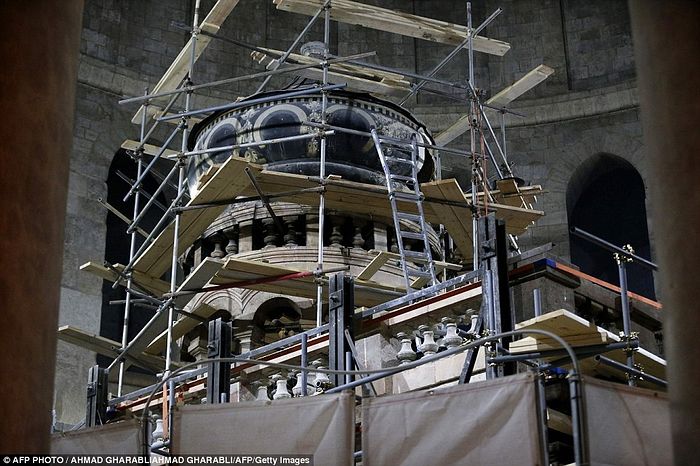 The shrine is being carefully restored. Its marble slabs have weakened over centuries, with the weight of thousands of daily visitors adding to the strain
The shrine is being carefully restored. Its marble slabs have weakened over centuries, with the weight of thousands of daily visitors adding to the strain
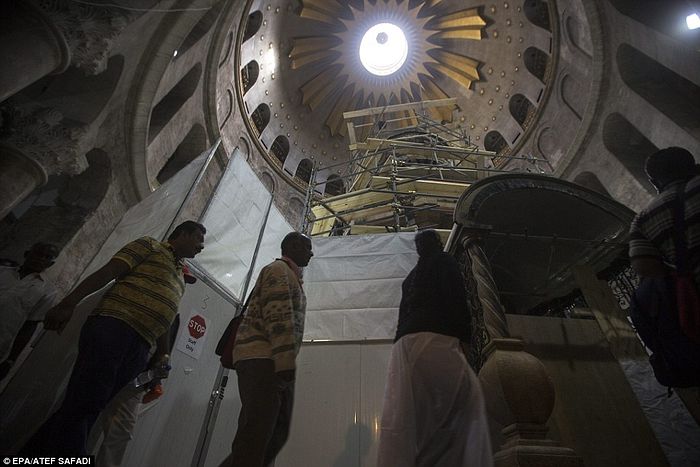 Christian pilgrims pass next to the tomb. National Geographic has been filming the work being done at the church, which is considered the most sacred site in Christianity
Christian pilgrims pass next to the tomb. National Geographic has been filming the work being done at the church, which is considered the most sacred site in Christianity
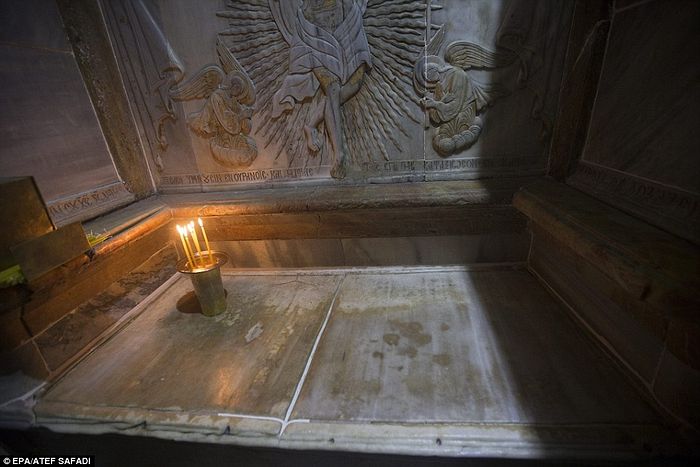 A view of the tomb of Jesus Christ. The researchers were shocked to find the second marble slab still intact when they opened up the tomb
A view of the tomb of Jesus Christ. The researchers were shocked to find the second marble slab still intact when they opened up the tomb
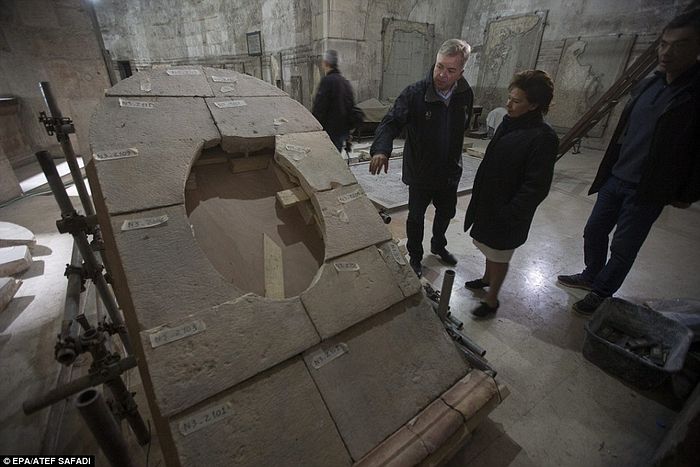 Antonia Moropoulou, professor at Athen's National Technical University of Athens and the Chief Scientific Coordinator of the restoration project (shown right) stands next to ancient stone
Antonia Moropoulou, professor at Athen's National Technical University of Athens and the Chief Scientific Coordinator of the restoration project (shown right) stands next to ancient stone
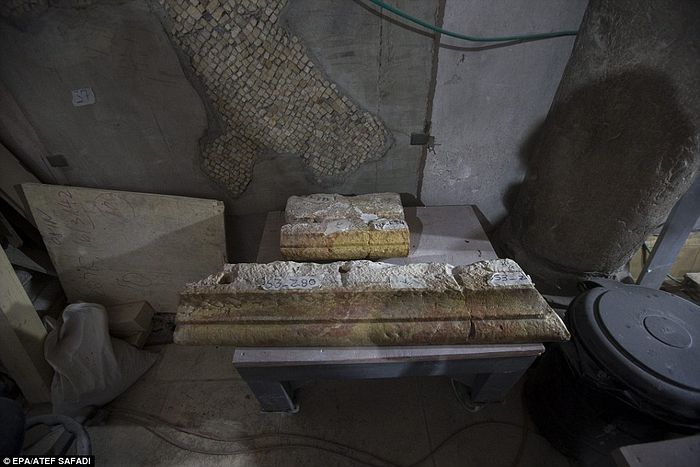 Stones taken from the tomb, pictured. The tomb has now been resealed and will probably not be opened again for hundreds, possibly even thousands, of years
Stones taken from the tomb, pictured. The tomb has now been resealed and will probably not be opened again for hundreds, possibly even thousands, of years
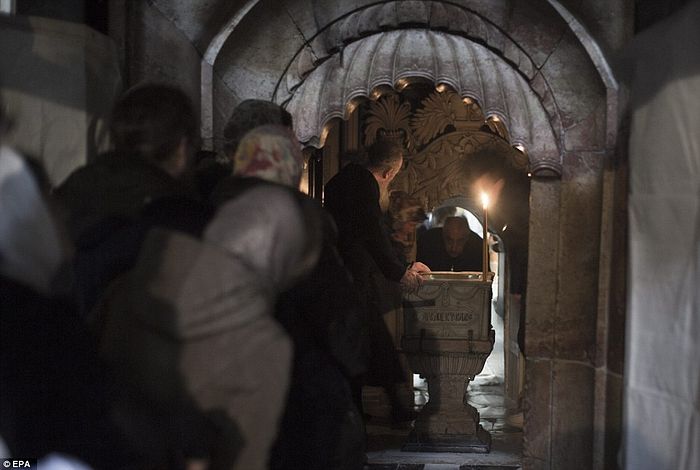 An ornate structure with hanging oil lamps, columns and oversize candlesticks, the Edicule was erected above the spot where Christian tradition says Jesus' body was anointed, wrapped in cloth and buried before his resurrection
An ornate structure with hanging oil lamps, columns and oversize candlesticks, the Edicule was erected above the spot where Christian tradition says Jesus' body was anointed, wrapped in cloth and buried before his resurrection
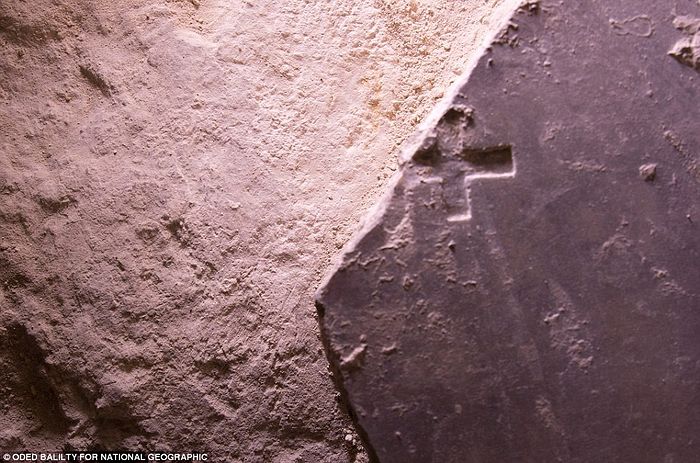 The tomb where Jesus Christ's body is said to have been rested was unveiled last month for the first time in centuries. As researchers continued their work over the course of 60 hours, another marble slab with a cross carved into its surface was exposed (pictured). Inscribed with a Christian cross, this broken marble slab may date to the Crusader era
The tomb where Jesus Christ's body is said to have been rested was unveiled last month for the first time in centuries. As researchers continued their work over the course of 60 hours, another marble slab with a cross carved into its surface was exposed (pictured). Inscribed with a Christian cross, this broken marble slab may date to the Crusader era
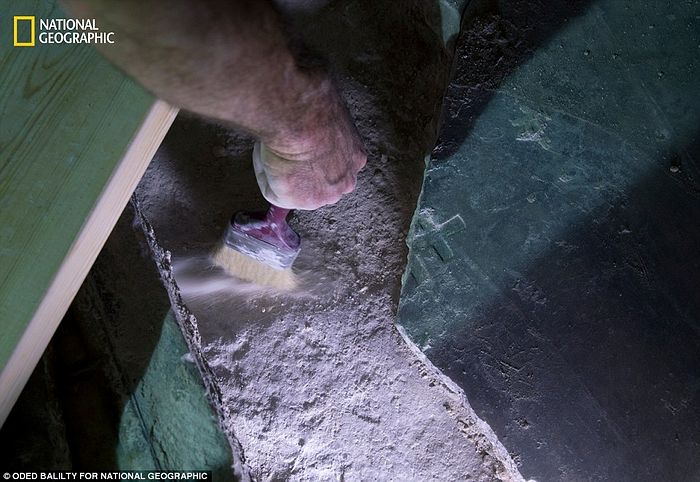 A restorer removes debris beneath a broken marble slab to expose the original rock surface of what is considered the burial place of Jesus. The original surface was exposed during the restoration work being done at the Church of the Holy Sepulchre in the Old City of Jerusalem. Until then, marble had encased the slab since at least 1555 AD.
A restorer removes debris beneath a broken marble slab to expose the original rock surface of what is considered the burial place of Jesus. The original surface was exposed during the restoration work being done at the Church of the Holy Sepulchre in the Old City of Jerusalem. Until then, marble had encased the slab since at least 1555 AD.
Christian tradition says Christ's body was laid on a slab cut from a limestone cave after his crucifixion by the Romans.
He was resurrected three days after his death, according to scripture, and the women who came to anoint his body said no remains were found.
The evidence for this is not definitive, however, according to Dan Bahat, a former district archaeologist in Jerusalem and in Galilee.
'We may not be absolutely certain that the site of the Holy Sepulchre Church is the site of Jesus burial, but we certainly have no other site that can lay a claim nearly as weighty, and we really have no reason to reject the authenticity of the site,' Bahat said.
An ornate structure with hanging oil lamps, columns and oversize candlesticks, the Edicule was erected above the spot where Christian tradition says Jesus' body was anointed, wrapped in cloth and buried before his resurrection.
It stands a few hundred yards from the supposed site of Jesus' crucifixion.
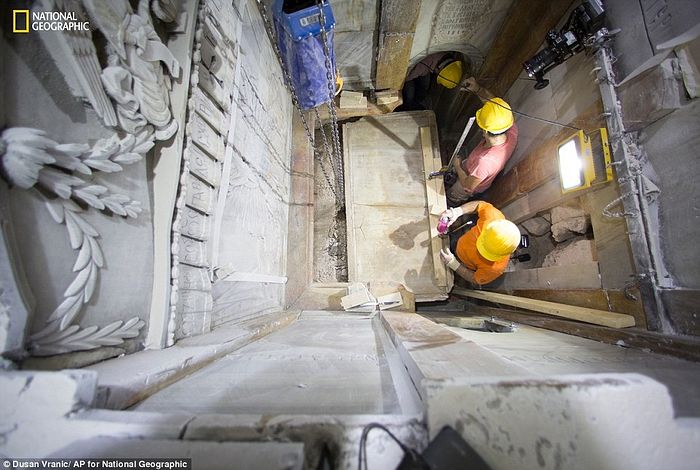 The burial slab (pictured being revealed from its marble case last month) many Christians believe once held the body of Jesus Christ has been uncovered by scientists for the first time in centuries. The original surface, partially shown in this picture, was exposed during restoration work at the Church of the Holy Sepulchre in the Old City of Jerusalem
The burial slab (pictured being revealed from its marble case last month) many Christians believe once held the body of Jesus Christ has been uncovered by scientists for the first time in centuries. The original surface, partially shown in this picture, was exposed during restoration work at the Church of the Holy Sepulchre in the Old City of Jerusalem
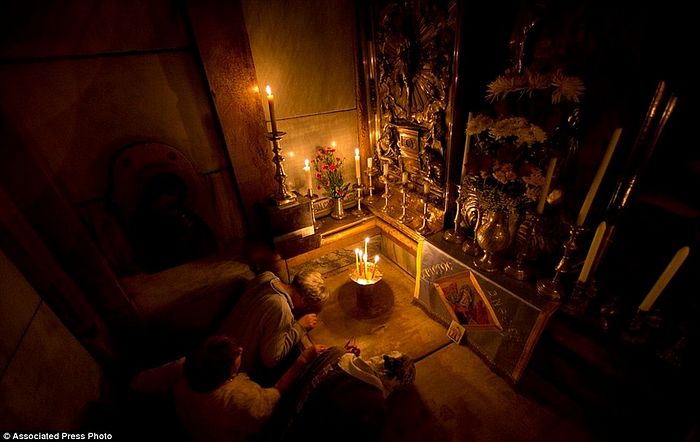 Christian tradition says Christ's body was laid on a slab cut from a limestone cave after his crucifixion by the Romans more than two thousand years ago. This slab had been encased in marble since at least 1555 AD. Worshippers are pictured praying to the slab underneath the marble casing, before it was uncovered
Christian tradition says Christ's body was laid on a slab cut from a limestone cave after his crucifixion by the Romans more than two thousand years ago. This slab had been encased in marble since at least 1555 AD. Worshippers are pictured praying to the slab underneath the marble casing, before it was uncovered
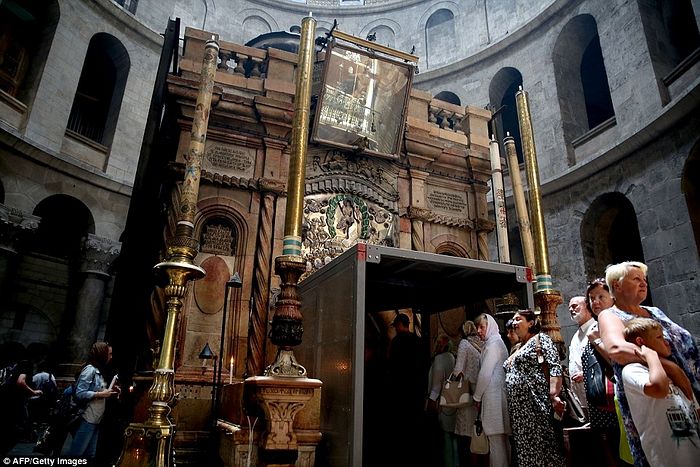 An ornate structure with hanging oil lamps, columns and oversize candlesticks, the Edicule was erected above the spot where Christian tradition says Jesus' body was anointed. With its stone staircases, gilded ornamentation and many dark chambers, the church is one of Christianity's holiest shrines
An ornate structure with hanging oil lamps, columns and oversize candlesticks, the Edicule was erected above the spot where Christian tradition says Jesus' body was anointed. With its stone staircases, gilded ornamentation and many dark chambers, the church is one of Christianity's holiest shrines
With its stone staircases, gilded ornamentation and many dark chambers, the church is one of Christianity's holiest shrines.
But that hasn't stopped clerics from engaging in turf rivalries over the years.
The Roman Catholic, Greek Orthodox and Armenian churches are responsible for maintaining separate sections, and each denomination jealously guards its domain.
While the clergymen who work and pray at the church generally get along, tensions can rise to the surface.
In 2008, an argument between Greek Orthodox and Armenian monks erupted into a brawl.
This time, the clergymen put aside their differences — a reflection of the dire need for the repairs.
Last year, Israeli police briefly shut down the building after Israel's Antiquities Authority deemed it unsafe, prompting the Christian denominations to join forces.
The Edicule and the tomb are currently being restored by scientists from the National Technical University of Athens.
The university's chief scientific supervisor Professor Antonia Moropoulou told National Geographic that it is 'the critical moment' for restoring the Edicule.
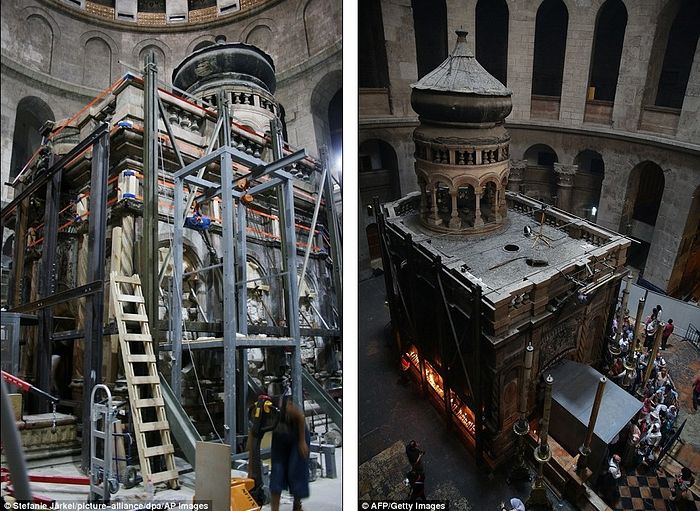 The original surface was exposed during the restoration work being done at the Church (left, in June, and right, in May)
The original surface was exposed during the restoration work being done at the Church (left, in June, and right, in May)
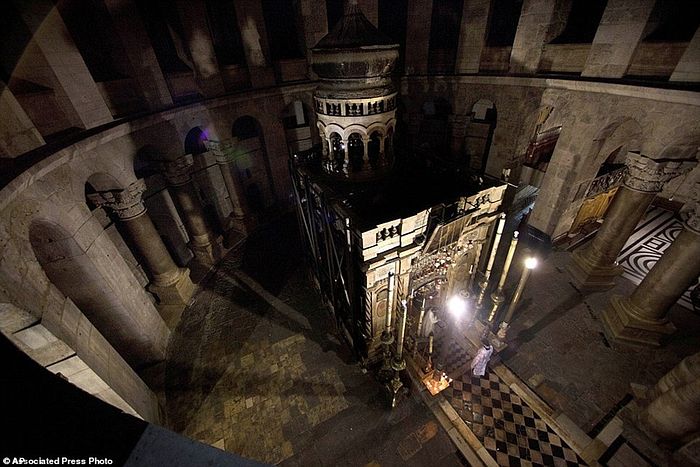 This photo shows what the tomb of Jesus in the Holy Sepulchre church has looked like for the past 200 years. It was last reconstructed in the early 19th century after a fire destroyed it. But repairs were long overdue as the structure it was damaged in an earthquake in 1927
This photo shows what the tomb of Jesus in the Holy Sepulchre church has looked like for the past 200 years. It was last reconstructed in the early 19th century after a fire destroyed it. But repairs were long overdue as the structure it was damaged in an earthquake in 1927
It was last reconstructed in the early 19th century after a fire destroyed it.
But repairs are long overdue as the structure was damaged in an earthquake in 1927.
Earlier this year, the Greek Orthodox Patriarchate of Jerusalem, as well as the the Roman Catholic Church, and the Armenian Orthodox Church (the three main out of six Christian sects that have custody of the church) invited the NTU to lead the restoration project.
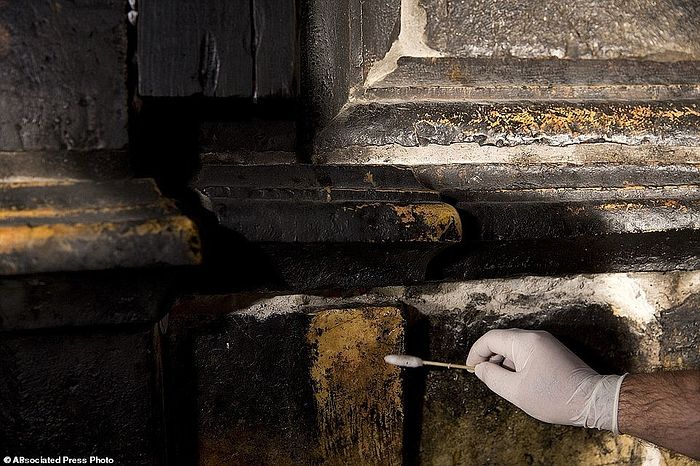 The Edicule and the tomb are currently being restored by scientists from the National Technical University of Athens. Using cotton swabs dipped into a solution of liquid soap and water, centuries-old layers of wax and carbon dioxide are scrubbed away by a restoration expert
The Edicule and the tomb are currently being restored by scientists from the National Technical University of Athens. Using cotton swabs dipped into a solution of liquid soap and water, centuries-old layers of wax and carbon dioxide are scrubbed away by a restoration expert
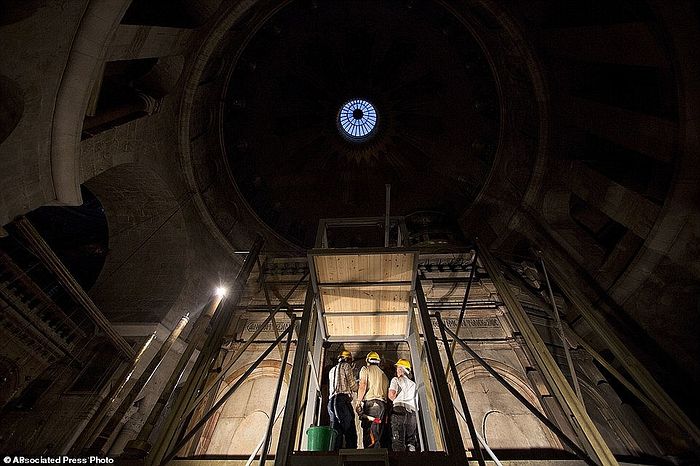 The Roman Catholic, Greek Orthodox and Armenian churches are responsible for maintaining separate sections, and each denomination jealously guards its domain
The Roman Catholic, Greek Orthodox and Armenian churches are responsible for maintaining separate sections, and each denomination jealously guards its domain
Work is expected to be complete in the spring of 2017.
The church, one of the world's oldest, was built in 325 A.D. by the Roman Emperor Constantine.
That structure was destroyed in 1009 by Muslim Caliph al-Hakim. A 12th-century restoration by the Crusaders gave the Holy Sepulchre its current appearance, while in 1808 a fire all but destroyed the Edicule.
In 1852, the Ottoman authorities then governing the Holy Land provided a framework for resolving disputes inside the church.
They put into effect the 'status quo,' a set of historic laws and power-sharing arrangements that rigidly regulates the denominations' activities inside the Holy Sepulchre.
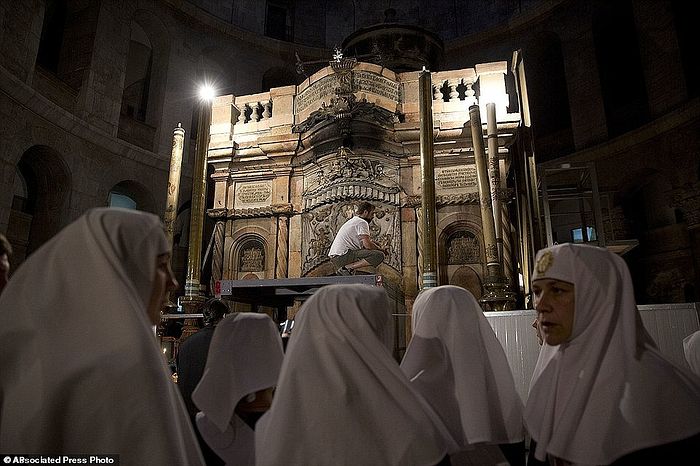 Christian nuns watch as renovations of Jesus' tomb in the Church of the Holy Sepulchre in Jerusalem's old city began earlier this year
Christian nuns watch as renovations of Jesus' tomb in the Church of the Holy Sepulchre in Jerusalem's old city began earlier this year
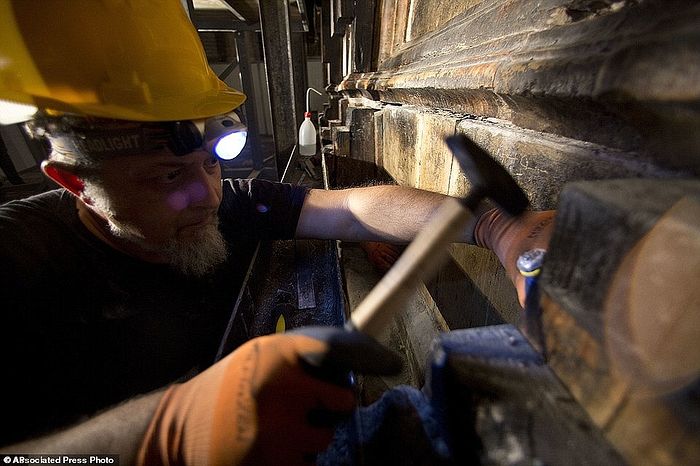 Earlier this year, the Greek Orthodox Patriarchate of Jerusalem, as well as the the Roman Catholic Church, and the Armenian Orthodox Church (the three main out of six Christian sects that have custody of the church) invited the NTU to lead the restoration project.
Earlier this year, the Greek Orthodox Patriarchate of Jerusalem, as well as the the Roman Catholic Church, and the Armenian Orthodox Church (the three main out of six Christian sects that have custody of the church) invited the NTU to lead the restoration project.
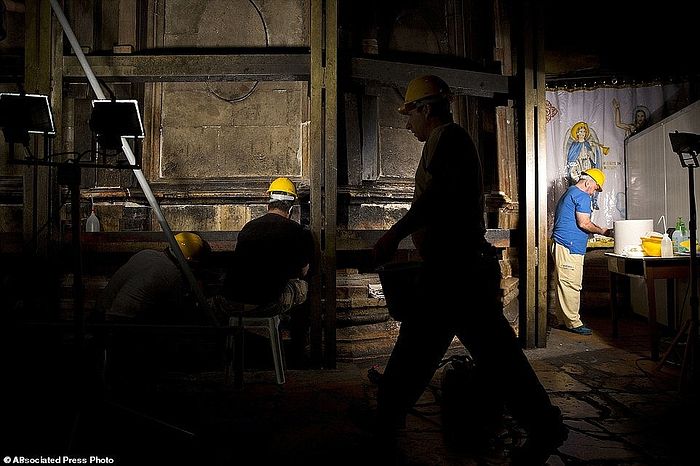 While the tomb is stable, it needs urgent attention after years of exposure to environmental factors like water, humidity and candle smoke
While the tomb is stable, it needs urgent attention after years of exposure to environmental factors like water, humidity and candle smoke
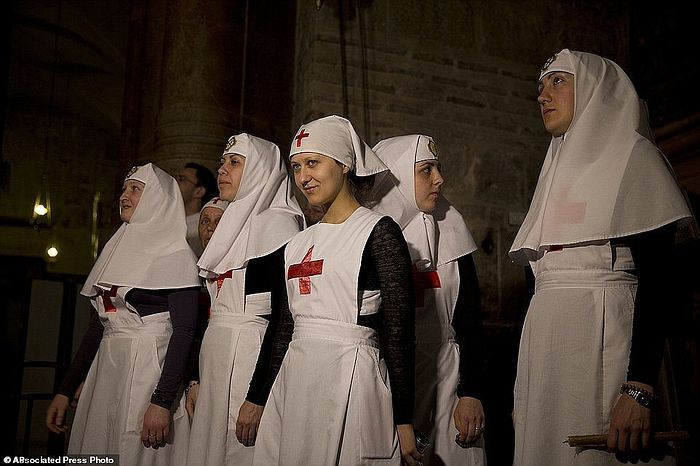 More than two centuries have past since the last time any restoration work was done in the chamber, partly because it is a holy site for many branches of Christianity
More than two centuries have past since the last time any restoration work was done in the chamber, partly because it is a holy site for many branches of Christianity
The Rev. Athanasius Macora, a Franciscan monk who represents the Catholics at the inter-church commission that negotiates disputes at the Holy Sepulchre, said the renovation might have been more ambitious if not for the status quo rules.
'I personally would have liked to maybe contemplate some alternative to simply restoring the current structure. But because the status quo is so conservative in its nature.
'We had to more or less accept the fact that there would be no change whatsoever to the current structure, and it would be restored as it is now,' he said.
Still, for pilgrims like Italian Claudio Pardini, the restoration is 'an important sign' that all of the Christian churches are getting together to preserve their faith's traditions.
'It's good to take care of our churches so that we can leave the next generations a sign, something to visit,' he said. 'Because Christ isn't an idea. He's a story.'
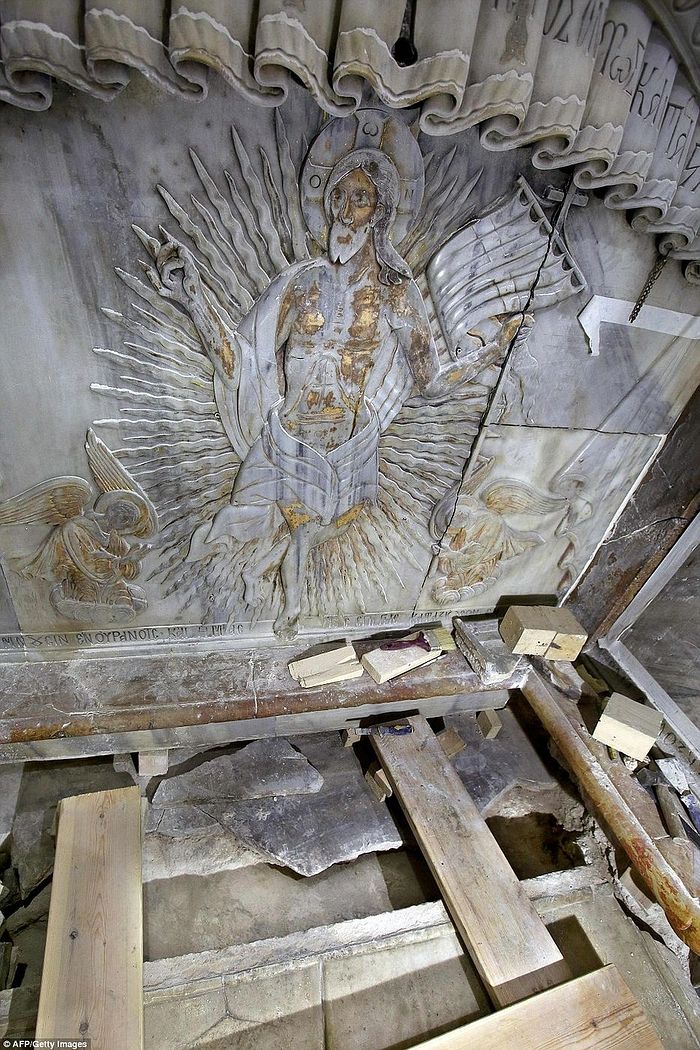 An ornate marble carving of Jesus Christ decorates the tomb where his body is believed to have been laid
An ornate marble carving of Jesus Christ decorates the tomb where his body is believed to have been laid
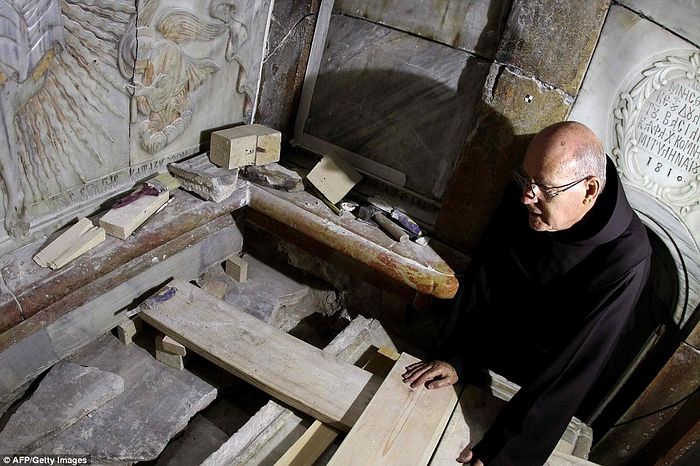 A Franciscan friar peers into the exposed tomb during the conservation work done by a team of Greek team of preservation experts in Jerusalem
A Franciscan friar peers into the exposed tomb during the conservation work done by a team of Greek team of preservation experts in Jerusalem
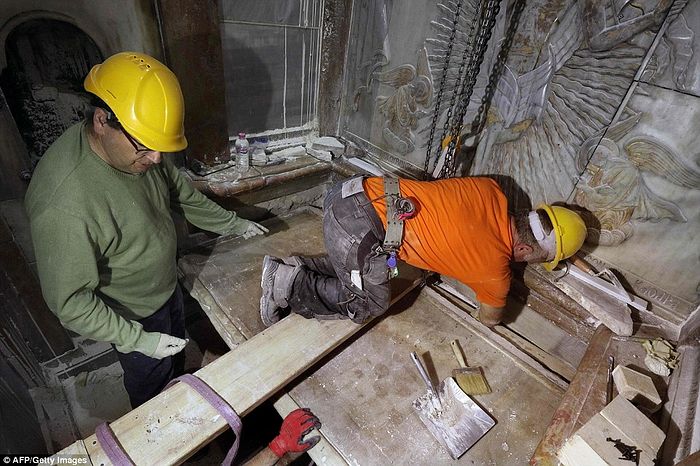 The preservation experts placed back the marble slab stone covering the tomb after three days of restoration works as part of the project at the historical holy site Archbishop of Canterbury visits Church of the Holy Sepulchre Loaded: 0%Progress: 0%0:00 Previous Play Skip Mute Current Time 0:00 / Duration Time 1:03 Fullscreen Need Text
The preservation experts placed back the marble slab stone covering the tomb after three days of restoration works as part of the project at the historical holy site Archbishop of Canterbury visits Church of the Holy Sepulchre Loaded: 0%Progress: 0%0:00 Previous Play Skip Mute Current Time 0:00 / Duration Time 1:03 Fullscreen Need Text


